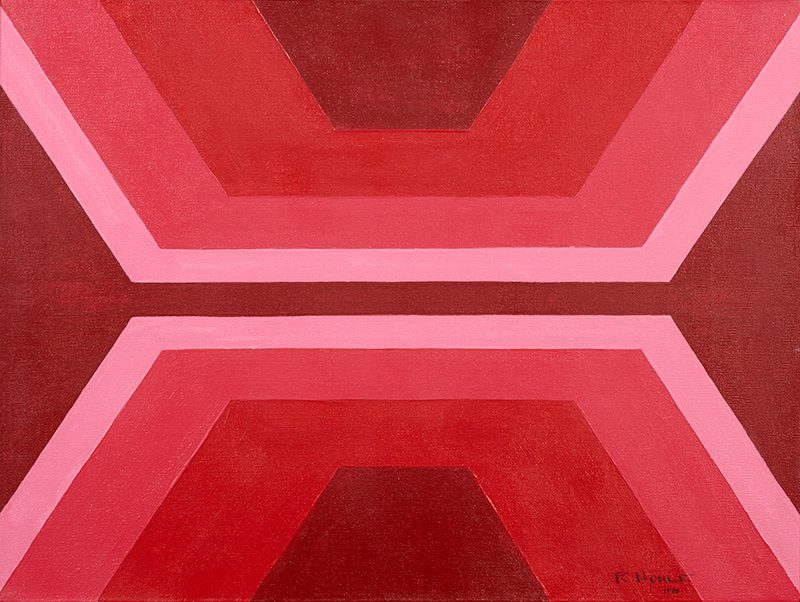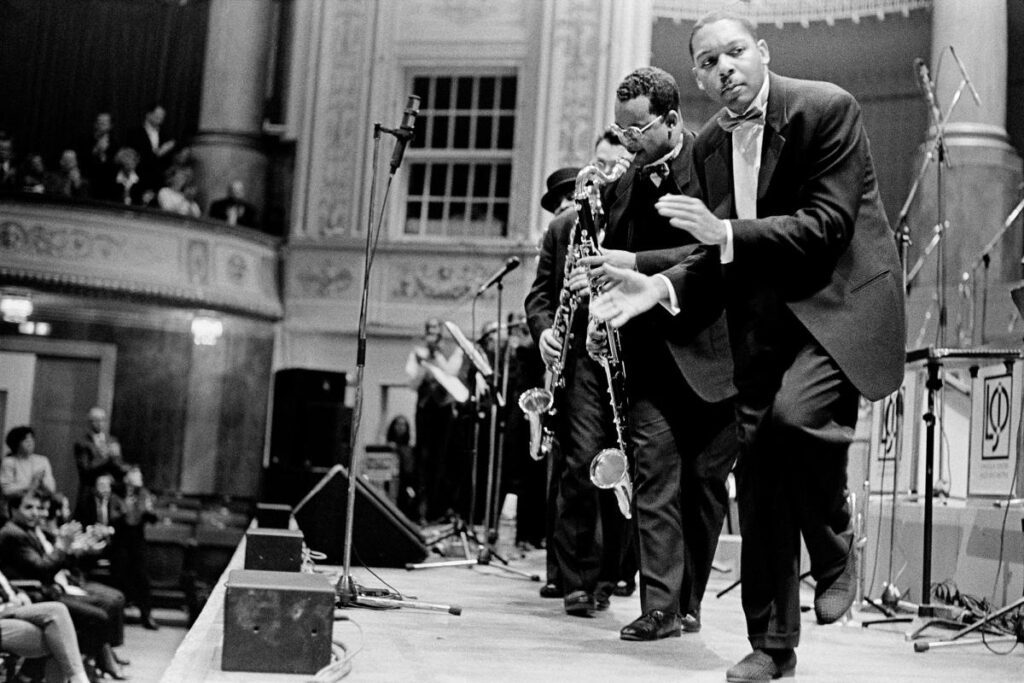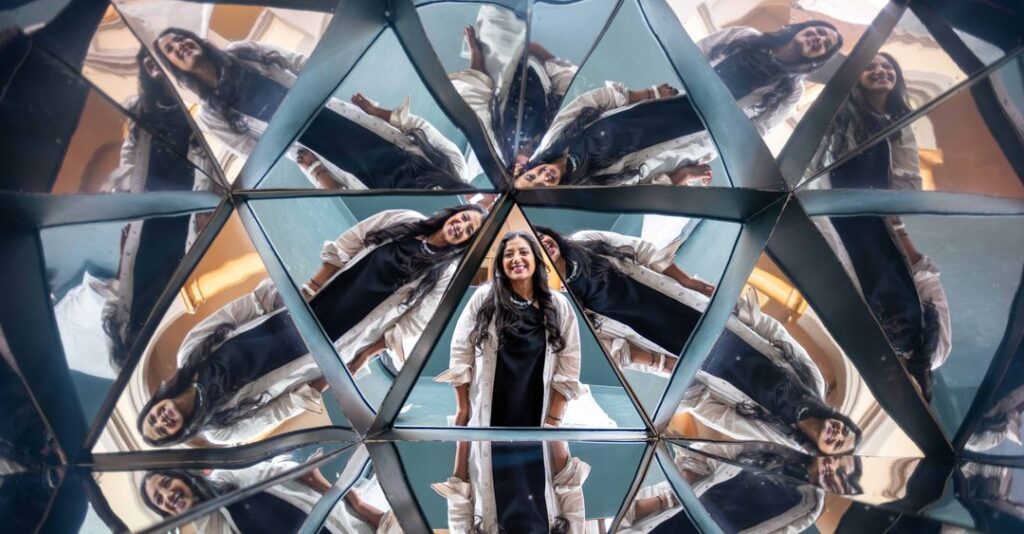Museum Picks: RBG, ‘Red,’ ‘Look Here,’ Frank Stewart
By • July 27, 2023 0 1315

‘Notorious RBG: The Life and Times of Ruth Bader Ginsburg’
“Notorious RBG: The Life and Times of Ruth Bader Ginsburg” — at the Capital Jewish Museum — is both a personal and political survey of the legendary justice’s life. Here, her life story is presented in three dimensions with everyday photographs and documents, furniture and clothing arranged in scenes. Her early life is re-imagined as a living room from her childhood Brooklyn apartment with a 1940s wall calendar, photograph of her mother, and old fashioned radio. In later years, a kitchen she and her husband Martin “Marty” shared includes items like his cooking whisk.
The highly personal collection of her school years and family scenes are the stuff of happy-ever-after storybook tales. However, even after a stellar career at Harvard Law School and Columbia University, Ginsburg still faced obstacles shared by American women in the work place — not having pregnancy coverage, lower pay and pension benefits.
The exhibit also explores the American legal system and Civil Rights movements further through the lens of the her role in public service through a series of wall texts outlining the major legal cases for which Ginsburg is noted.
In a pivotal moment in her mid life, Ginsburg would move from one side, before the bench, trying cases to behind the bench and interpreting the law when she was appointed by President Jimmy Carter to be a federal judge to the U.S. Court of Appeals for the District of Columbia Circuit in 1980. This would lead to more groundbreaking cases and to her appointment — as only the second woman, and the first Jewish woman — to the U.S. Supreme Court by President Clinton in 1993.
Law books along with personal items, her robe and jabot from her Supreme Court wardrobe, her souvenirs, her official portraits on the Supreme Court along with photos of her family rafting —are all part of her life’s story.
Viewing RBG through family photos set amidst her personal objects, reminds this writer of seeing her in person in places such as the Washington National Opera. For those of us in Washington, this exhibit now is a chance to remember our shared experience of a remarkable woman who saw and chose to work for what connects us all as citizens and women.
Admission to the museum and core exhibitions is always free. The cost for special exhibitions, including “Notorious RBG: The Life and Times of Ruth Bader Ginsburg,” and programs varies. Members enjoy free admission to all exhibitions and discounts on programs. “Notorious RBG: The Life and Times of Ruth Bader Ginsburg” runs through Nov. 30.
For more information about the Lillian and Albert Small Capital Jewish Museum at 575 3rd St. NW, visit https://capitaljewishmuseum.org/.
— Celia Sharpe

Robert Houle, “Red Is Beautiful,” 1970. Acrylic on canvas, 45.5 x 61 cm. Courtesy Canadian Museum of History.
Robert Houle’s ‘Red Is Beautiful’ at NMAI
Red is beautiful. For Robert Houle (Saulteaux Anishinaabe, Sandy Bay First Nation, b. 1947), color is powerful, expressive, and lies at the foundation of his artistic practice. Throughout his career, his work has embodied and expressed what he most values: the creative moment, the earth and the sacred.
The spiritual power of ancient Indigenous knowledge not only endures, but also is essential to Houle’s creation of contemporary art. He works at the nexus of Western and Indigenous artistic traditions, whether he pierces the canvas with porcupine quills, reworks a grand history painting from an Indigenous perspective, or reconceives what is sacred while acknowledging his ancestors. In this way, Houle constructs a transcultural path forward with color, light, and gesture, grounded in Indigenous sovereignty. “Red Is Beautiful,” the first major retrospective of his work, celebrates more than 50 years of this singular artist’s remarkable career and runs June 2, 2024.
National Museum of the American Indian National Mall, Fourth Street & Independence Avenue, SW

Frank Stewart’s “Juneteenth ’93, 19th of June Celebration, Mexia, Texas.” Courtesy Phillips Collection.
‘Frank Stewart’s Nexus: An American Photographer’s Journey’ at the Phillips
“Frank Stewart’s Nexus: An American Photographer’s Journey, 1960s to the Present” — at the Phillips Collection — is an energetic exciting experience, one that’s most enjoyable in its exploration of Black culture in America and specifically the many forms of African-American music now part of America’s heritage, gospel, blues and jazz.
The hundred photographs by Stewart in this visual memoir of his life with his camera is arranged along thematic lines that follow his career starting from his first photograph as a teenager in 1963 of the seminal March on Washington for Jobs and Freedom.
From his original home in Memphis, Stewart traveled the world, while he studied with great photographers-mentors, such as Roy DeCarara, Garry Winogrand, Jack Whitten and Romare Bearden.
Central to this story is his 30 years of travels internationally as senior staff photographer with the Jazz at Lincoln Center Orchestra. This afforded him the opportunity to capture both public and personal moments, of celebrity musicians as well as images of native peoples in other world cultures. Featured are jazz legends Miles Davis, Ahmad Jamal and Wynton Marsalis. Stewart also records events of unnamed tribal dancers and drummers in Ghana and carnival goers in Cuba.
In more recent experimentations with photography, he created the painterly “Drawings” series which captures reflections, walls, cars, and children at play — of which Stewart has said it’s “all made up on-the-spot just like a jazz musician improvises on a riff.”
In the last 20 years, with changes in image technology, Stewart has shifted to larger works in color. In these images, he captures the ever-changing landscape and environmental catastrophes —the aftermath of Hurricane Katrina in New Orleans between 2005-07 and the more recent devastating fires in California and the Pacific Northwest.
What makes these photographs so great? In a 2015 interview in “Jazzblog,” Stewart delineates that great photographs are either about subject matter, the medium or the person who is taking the picture. He said that he liked his “photographs to talk about me, and I always like to talk about how I feel about the world, so the great photographs talk about all three.”
While he’s not in the images of wedding receptions or Memphis barbecues or in his exploratory travels, he’s very much part of the scene in these works which seem to
expand beyond their borders, almost in to a third dimension, to include the viewer to be present with what’s going on.
If there were calls for encore performances, “Frank Stewart’s Nexus: An American Photographer’s Journey, 1960s to the Present” would certainly deserve another round of viewing for visitors who enjoy being captivated by his historical and reflective collections. A Spotify playlist features songs by musicians in the exhibit.
“Frank Stewart’s Nexus: An American Photographer’s Journey, 1960s to the Present” runs through Sept. 3. Information about the show and events can be found at PhilipsCollection.org/events.
— Celia Sharpe

“Look Here” by Suchi Reddy. Courtesy National Building Museum.
‘Look Here’ — 7th Summer Block Party at National Building Museum
The seventh Summer Block Party installation at National Building Museum is “Look Here” by Suchi Reddy. The installation fills the museum’s colossal Great Hall while engaging, delighting, and even challenging visitors.
Founded in 2002, Reddy’s firm Reddymade Architecture and Design uses the guiding principle “form follows feeling,” a design ethos shaped by neuroaesthetics, the study of the brain’s response to design. Their diverse architectural and artistic work is driven by the belief that architecture and spatial experience have an impact on how we feel, how we shape society, and the positive contribution we can offer through design.
For “Look Here,” Reddy has designed a constellation of reflective fractals that visitors encounter on the oval ramp that fills the Museum’s Great Hall. Overhead are three oversized mirrored elements resembling fortune-teller toys, whimsical folded paper playthings beloved by generations of kids. The reflection of the Museum’s interior, the constant movement of the prismatic elements, and the changing sun create a spectacular contemplative space during the day and a lively entertainment space at night.
As visitors make their way along the ramp, they encounter iconic images of activist gatherings in Washington, D.C., such as the 1963 March on Washington, which marks its 60th anniversary this August. The photos underscore the idea that Washington was designed to not only house the seat of government but to be a physical representation of democratic ideals and beliefs. It furthers Reddy’s philosophy that buildings and landscapes impact how we feel and, in turn, shape our society.
“Look Here” — which runs through Sept. 4 — engages with the immense scale of the Great Hall, using perspective as a way to understand life as well as a mechanism to study architecture. Using the movement of the body through space to amplify experience, visitors can see shifting forms, both with the naked eye and their camera lenses.
National Building Museum, 401 F St. NW — info@nbm.org — 202-272-2448. Open 10 a.m. to 4 p.m., Thursday through Monday,

